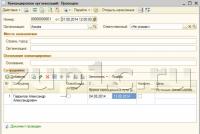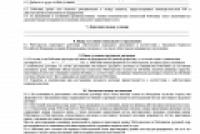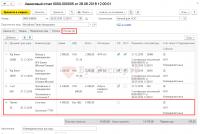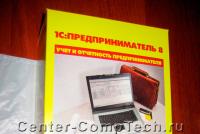Business trip turning into 1s. Accounting info. Early return from a business trip
Hello dear blog readers. Not so long ago, on the pages of the blog, issues related to sick leave and vacation pay were considered in some detail. In these materials, I presented quite interesting possibilities that many did not know or forgot about. If you have not read these publications, then you can familiarize yourself with them and. This will be useful for both beginners and experienced users of the 1C ZUP software product.
Today we will consider how the program performs accrual for the time spent on a business trip, namely the document. This will be a kind of continuation to the previously mentioned materials and it will also be useful for experienced users of 1C ZUP, since I will analyze difficult examples of charges. In the examples, we will analyze two options for paying for business trips in which the employee worked on weekends / holidays:
- Payment in a single amount on average earnings (using "Individual schedules");
- Double payment (using document "Payment of holidays and weekends of the organization").
A bit of theory
✅
✅
✅
The concept of a business trip is quite clearly stated in Labor Code of the Russian Federation in Article 166: “ Business trip - a trip of an employee by order of the employer for a specified period to carry out a service assignment outside the place of permanent work. Business trips of employees whose permanent work is carried out on the road or has a traveling nature, are not recognized as business trips. "
I will also highlight the position of the article 167 of the Labor Code of the Russian Federation: "When sending an employee on a business trip, he is guaranteed the preservation of the place of work (position) and average earnings, as well as reimbursement of expenses related to the business trip."
Options for calculating travel allowances arise in the event that the days of a business trip fall on weekends or holidays. If work on weekends or holidays was not provided initially, then for work on such days on a business trip, double wages are provided - article 153 of the Labor Code of the Russian Federation.
If work on weekends and holidays has been foreseen in advance and spelled out in the order or job assignment for a business trip, then such days are calculated according to the average earnings.
Travelers on average earnings + pay for work on weekends in a single amount (using "Individual schedules")
✅ Seminar "Lifehacks on 1C ZUP 3.1"
Analysis of 15 life hacks for accounting in 1s ZUP 3.1:
✅ CHECK LIST for checking payroll in 1C ZUP 3.1
VIDEO - monthly self-checking of accounting:
✅ Payroll in 1C ZUP 3.1
Step-by-step instructions for beginners:
So, according to the conditions of the example, the chief engineer for maintenance of the equipment of our car service was sent on a business trip to a neighboring city, where the opening of a branch is being prepared, to help in setting up the equipment. The business trip is calculated for 10 days - from 04/08/2014 to 13/08/2014. At the same time, work is planned on Saturday (09.08) and Sunday (10.08). In connection with this, the employee's planned work schedule for August is changing, which all the previous months of his work was unchanged - a 40-hour five-day period.
First of all, we will introduce an individual schedule for this employee for August 2014. For this we will use the document "Entering individual work schedules for the organization"... It can be found on the program desktop on the Payroll tab in the middle column. In the document, we indicate the month August and add a new row in the tabular section, in which we select the employee Gavrilov. In this case, the line will be filled with information about the planned schedule of this employee. Set in cells for August 9 and 10 at 8 hours of working time. At the same time, upon returning from a business trip, the employee will be given a weekend on Friday and Saturday. Therefore, we remove the eights in the cells for August 14 and 15. We post the document.
Further, if the organization maintains detailed personnel records, then we create a document of the personnel accounting subsystem Organization's business trips. This document does not calculate the amounts, but is a personnel document - it must be entered by an employee of the personnel department. It can be found on the desktop of the program on the "Personnel accounting" tab.

You can open this processing by clicking on the "Open charges" button in the personnel document "Business trips of organizations".

So, let's create, calculate and post the document "Payment by average earnings". Let's open it and see what the program counted for us. Thanks to the use of the "Absence analysis" processing, all fields were filled in automatically and the calculation was made.

To analyze the calculated amount, it is convenient to open the printed form of this document - "Calculation of average earnings".

Please note that since the employee has been accepted into the organization since January 1, 2014, the income is taken into account not for 12 months as expected, but for 7. In addition, the working days of July are not fully taken into account since the employee was on vacation for half a month. So the calculation of travel allowances is carried out according to the formula:
Average_day_ earnings * Number of_of_working days \u003d Income_for_the_billing_period / Considered_days_of_the_billing_period * Number_of_of_working \u003d 229 782.61 / 130 * 10 \u003d 17 675.60
The program took into account exactly 10 days of a business trip, since we introduced an individual schedule, where Saturdays and Sundays falling on a business trip are marked as workers.
Business travelers on average earnings + payment for work on weekends in double the amount (document "Payment of holidays and weekends of the organization")
✅ Seminar "Lifehacks on 1C ZUP 3.1"
Analysis of 15 life hacks for accounting in 1s ZUP 3.1:
✅ CHECK LIST for checking payroll in 1C ZUP 3.1
VIDEO - monthly self-checking of accounting:
✅ Payroll in 1C ZUP 3.1
Step-by-step instructions for beginners:
So, let's change the conditions of our example a little. Employee Gavrilov went on a business trip on the same date, but work on Saturday and Sunday was not expected. Already on the spot, it was decided to go out on weekends to resolve urgent issues. Consent was obtained from the management.
Since it was not known in advance that the employee had to work on weekends, his work schedule for the 40-hour five-day week would not change (we will not use individual schedules). As in the previous example, we will introduce a personnel document Organization business trips on the basis of which we will create a settlement document "Payment by average earnings"using processing "Analysis of no-shows"... Let me remind you that you can read in detail about the use of this processing.

Let's open the generated and calculated document "Payment by average earnings" and analyze the amount received.

Average daily earnings have not changed, and this is correct, since we did not change anything in the billing period. But the amount of payment has changed, since the working days of travel, at the time of calculation of this document, 8 (Saturday and Sunday weekends according to the schedule). From here we get: 1,767.56 * 8 \u003d 14 140.48 rubles.
Now you need to reflect your pay for work on weekends at double. For this we will use the document "Payment of holidays and days off of the organization." The document should look like this:

In total, the document should contain 4 lines, two for each day. Payments are made according to two types of calculation "Payment for work on holidays and weekends" and "Supplement for work on holidays and weekends." It is better to fill in manually. In this case, the data in the "Hourly tariff rate" field is calculated automatically by the program. The options for calculating this indicator are configured in "Accounting parameters" on the bookmark "Calculation Algorithms" in the radio button group "When converting a monthly salary into an hourly wage rate, use:"... I analyzed these settings in detail in the corresponding article. The "Result" field is also filled in automatically based on the results of the data in the "Hours worked" and "Hourly rate" fields. We post the document.
Summarize. Both examples essentially reflect two options for working on a day off, which are provided for by the Labor Code of the Russian Federation. The first example is essentially a day off job. Upon returning from a business trip, the employee receives two days off. The second example is double payment for work on a day off.
This is the simplest example and therefore I will not illustrate it separately.
That's all for today! There will be new interesting materials coming soon.
To be the first to know about new publications, subscribe to my blog updates:
The daily allowance is reimbursed to the employee for each day of being on a business trip, including weekends and public holidays, as well as for days on the road.
The main procedure for reflecting business trip costs was reflected in Consider the main operations in 1C 8.3 according to registers when using the simplified tax system
Document Cash withdrawalin connection with the use of the simplified tax system makes the following movements:
- By accumulation register Book of accounting of income and expenses (section I). The expense for the purposes of the simplified taxation system will be taken into account after the employee reports the expenses and the document is drawn up Advance report:
- Accumulation register Other settlements:

Confirmation of expenses in the form of daily allowances in 1C 8.3 is drawn up using a document Advance report. It's in the section Cashier and bank - Cashier.
When conducting a document in the part concerning the simplified tax system, movements will be formed in the following registers:
- Income and expense book (Section I) - the amount of expense that will be taken into account to determine the tax base:

- Decryption of KUDiR - separately costs and VAT are decrypted in detail:

- Other calculations - reflects the amount of funds spent that were actually spent. Indicated on a bookmark Other. That is, if more was spent than was issued, then in the column Settlement document the current Advance Statement will be indicated and the amount of overspending will be highlighted in a separate line:

Expenses under the simplified tax system - records are made with the current statuses of payment for the expenses of the simplified tax system:
- Receipt - records with actually spent amounts with the Not paid status;
- Expense - records confirming the payment of expenses, that is, the issuance of reporting amounts that remove the Not paid status from the issued reporting amounts:

Daily allowance and income tax
The cost of paying an employee's daily allowance is included in other expenses in accordance with paragraphs. 12 p. 1 art. 264 of the Tax Code of the Russian Federation.
The daily allowance includes:
- With the accrual method - in the reporting tax period in which the advance report was approved;
- With the cash method - after the actual payment of per diems.
In 1C 8.3, only the accrual method is supported, therefore, per diems are recognized as expenses when the document is posted Advance report:

Personal income tax and daily allowance in excess of norms
The daily allowance is exempt from personal income tax in the following cases:
- For each day of being on a business trip in the Russian Federation, the amount of per diem is not more than 700 rubles;
- For each day of a business trip abroad, the amount of per diem is not more than 2,500 rubles.
Important: Clause 11 of the Regulations on Business Trips states that an employee is not entitled to a daily allowance for a one-day business trip. Moreover, in the decree No. 4357/12 dated 11.09.2012. The Supreme Court of the Russian Federation speaks about the admissibility of reimbursement of daily allowance for a one-day business trip. Therefore, when deciding on the payment of per diem, all the above norms will apply (clauses 1.4 and 6 of article 226 of the Tax Code of the Russian Federation).
The same norms should be taken into account when additional compensation is paid instead of per diem. expenses (letter of the Ministry of Finance of Russia No. 03-03-06 / 30062 dated May 26, 2015, 03-03-06 / 1/24916 dated May 26, 2014, No. 03-04-06 / 6394 dated 03/04/2013, No. 03 -04-07 / 6189 dated 01.03.2013).
The daily allowance paid in excess of these norms is subject to personal income tax. Wherein:
- Date of receipt of income - the last day of the month in which the advance report was approved;
- Date of payment of personal income tax - the day following the day of receipt of income.
Let's consider how this situation is reflected in the program 1C 8.3 Enterprise Accounting 3.0.
In chapter Directories - Salary and personnel - Accruals create a new type of accrual as shown in the figure below. At the same time, check if there is already this type of charge in the list:

Check the box Income in kindso that per diems are not reflected in the payroll, but only participate in taxation and there is no balance on account 70.
Field Reflection method we will leave it blank, since the transaction will not be generated, because the document Payrollcannot form the posting Dt 26 - Kt 71.01. Such a posting will form a document Advance report.

Attention: the reflection of per diems for the purposes of personal income tax and insurance premiums in 1C 8.3 can also be carried out using the documents Operation of personal income tax and Operation of accounting for insurance premiums instead of the Payroll document.
If you look at the result of the document, you can see that the daily allowance amount was not reflected on account 70, and the entries for the accrual of personal income tax and insurance premiums were formed:

To reflect the compensation of daily subsistence allowances in excess of the norms in accounting, you can use the document Cash withdrawal through section Bank and cash desk - Cash documents:

We see the transactions generated as a result of document movement:

Daily and insurance premiums
Per diems within the limits are not subject to insurance premiums, as they relate to compensation payments related to the performance of the employee's work duties.
As for day trips, there are different opinions on whether or not to tax such trips.
Therefore, if it is necessary to accrue insurance premiums, then you can arrange this type of accrual as an independent one, similar to the compensation of daily allowances in excess of the norms and add it to the document Payroll,which is considered in the example above for daily allowances in excess of the norms.
If you do not plan to impose insurance premiums, then such per diems in 1C 8.3 are reflected as usual on the tab Other in document Advance report.
Almost no accountant in his work does not do without formalizing the directions of employees on business trips. Such a trip of an employee may entail not only registration and calculation of payment, but also raise certain questions, for example, when a business trip coincided with a weekend. Such cases are quite common, thereby providing the accountant with some difficulties in the registration and accounting of business trips in 1C. Let's try in this article to figure out how the work with business trips is organized in the "1C: Salary and Personnel Management 8" version 3.0.
So, in the section "Salary" there is an item "Business trips".
This item will be active if in the initial payroll settings the checkbox is checked in the corresponding position. 
To work with the document "Business trip", one checkbox is enough. The second checkbox, which concerns intra-shift absence, is required in the case when, for example, an employee was on a business trip for part of the day, and the rest of the working time was in the office.
Let's go back to the "Salary" section, by accessing the "Business trips" item, the form of a list of documents opens. 
We can see that there are two buttons with a create function. Using the first button, a document is created for registering and calculating the payment for a trip of one employee. 
We indicate the month in which the calculations reflected in this document will be recorded, by default the current month is set. Do not forget that the date is used in printable forms. From the directory "Employees" choose the right one.
This is how the "Main" tab looks, provided that there is no "check mark" in the settings that is responsible for an intra-shift business trip. It is required to set the beginning and end of the trip. If the staffing table is maintained in the program, the option to release the rate for the absence period is available by checking the box. The average earnings and accruals are automatically calculated using the previous earnings data. It is necessary to decide how the payment will take place, from the proposed options, a suitable one is selected.
When a business trip ends not this month, but the next, the program allows you to determine how you plan to pay in full or on a monthly basis. Choosing the second option, we ensure that this document is accrued only for the current month, the payment for the remaining months will be calculated when the salary is calculated. The average earnings for such calculations in the future corresponds to the value obtained in the document "Business trip". 
When you go to the "Accrued (in detail)" tab, we can see a detailed calculation indicating the number of days worked. 
On the "PFR experience" tab, the only field "Territorial conditions" is available for filling, which is filled out from the reference book of the same name. It is used when the employee is sent to special territorial conditions. 
For printed forms, it is required to fill in the "Additional" tab, we enter information about where the employee was sent, how many days he spent on the road, the basis, funding and purpose of the trip. 
After filling out the document, we write it down and conduct it. We have the opportunity from this document to print the order on the direction and calculations, as well as a travel certificate and a service assignment. The last two positions from 2015 are not required to be issued. 
If the organization has accepted a combination of positions and this is noted in the program settings, then on the basis of the "Business trip" document it is possible to create a document "Combination of positions" in order to assign an additional payment to someone who will, for example, perform the duties of an employee who has gone on a business trip.

Or another situation: a traveled employee has a part-time job, then a hyperlink appears right in this document to register his absence as a part-time job. 
The "Pay" button comes into effect if you select a payment in the inter-settlement period, because in other cases, the payment is carried out together with the salary. 
We can also notice that with this choice of payment, deductions are calculated. We observe a similar picture when choosing "With advance payment". By "pencil" details of the calculation of deductions and average earnings are revealed. 
Above, filling out the "Business trip" document by clicking on the "Create" button was considered, when you click on the "Create T-9a" button, we will turn to the formation of an order for business trips of several employees at the same time. 
Filling occurs by clicking the "Add" button. In the course of entering data into the tabular section, we will receive information in the form of a hyperlink in the last column "Accounting for absences and accruals". As you can see, in our example, absences for the first employee are taken into account, since the document "Business trip" has already been entered for him, and for the second one needs to be issued. That is, in order to complete the processing of business trips, in order to calculate the salary for this period, it is necessary for each traveled employee to enter a separate document "Business trip" by hyperlink.
Now let's touch on some difficult circumstances. What to do when a business trip falls on a weekend? Working days and days off of an employee on a business trip are also determined according to the schedule of the main place of work. It follows from this that if an employee was resting on a business trip on weekends, then there is no need to add anything to the program. If he worked on these days, then we bring in the document "Payment of holidays and weekends."
Those working days that the employee spent on a business trip are reflected in the report card with the letter "K". 
As for the intra-shift business trip, which was mentioned at the beginning, when it was said about the setting of flags in the accounting of absences. Then, if there is just the second checkbox, on the main tab of the "Business trip" document, it becomes possible to enter data on a business trip for an incomplete day. 
As a result, we will see the following combination in the timesheet: 
This is how the design and calculation of payment for an employee sent on a business trip looks like. Please note that the type of documents and the ability to enter information depend on the initial settings.
At the enterprise, quite often there are situations when an employee needs to pay for the period of work by average earnings in accordance with the Labor Code of the Russian Federation.
The most common case is the payment for the period of an employee's stay in business trip.
For this, the 1C Salary and Personnel Management program provides a document ““.
You can find it in the program on the "Payroll" tab of the desktop, the link "Pay by average earnings" or in the main menu of the program, item "Payroll of the organization" -\u003e "Absenteeism" -\u003e "Pay by average earnings".

In the list of documents that opens, enter a new one using the "Add" button. A new document form opens:

Required details for the calculation:
Organization (if a default organization is defined in the user settings, then it will be substituted automatically when a new document is created);
Accrual month - the period in which the document will be registered;
The employee who is paid according to the average earnings;
The start date of the average earnings saving period (this date is important when average earnings registered during one period by several documents, as well as to clarify the calculation period used to calculate average earnings);
Paid time period: whole day or intrashift.
To pay for a business trip, you need to set the switch to the "all-day" position. In this case, the details "from" and "to" will become available, which must be filled in with the start date and the end date of the trip, respectively.
If you set the position of the switch to the "intra-shift" position, you must fill in the date of payment according to the average earnings and the number of hours of payment. But in our case, we will not do this.
Below there is a group of attributes "Accrue". In the variable "type of calculation", the types of calculation calculated by the average earnings are available for selection - whole-day or intra-shift, depending on the position of the switch.

We select the type of calculation "Pay by average". In order to make sure that in the time sheet T-13 this type of calculation will be displayed correctly and it will be counted as we need it, you can open this type of calculation for viewing by using the button with magnifying glass.

The form for setting the type of calculation "Pay by average" will open. The Calculation tab contains the calculation formula:

On the “Time” tab, make sure that the type of time is specified correctly: “Unworked full shifts, as well as business trips”.
The type of time according to the classifier of the use of working time is also set correctly: “ Business trip"(Letter designation" K ").

Let's close the calculation type form and start calculating our document. Click on the "Calculate" button, and if there is a payroll for the previous 12 months in the database, the system will automatically calculate both the average daily earnings and the payroll based on the average earnings during a business trip:

We can consider the details of calculating the average earnings by going to the "Calculation of average earnings" tab:

As you can see, in addition to the basic monthly earnings, various bonuses can also be included in the average earnings: fully or partially accounted for, indexed and not. In our case, there were no premiums for the previous 12 months.
On the “Payment” tab, you can view the details of calculating the average amount charged.

The row of the tabular section displays the start and end dates of payment, the type of accrual, the number of paid days and hours, the result, and the start date of the event.
Below the table is an information line with the total amount of payment and the number of paid days.
We post the document (the "Post" button is located in the upper command bar of the document form. In order to simultaneously post and close the document, the "OK" button is intended).
We will form a document "Timesheet" for May for Akimova's employee.

Make sure that our business trip displayed in it with the letter "K". Please note that I have entered the period from May 6 to May 9, i.e. 5 calendar days, but the program paid only for working days. This is correct, because weekends and holidays on a business trip paid by the document "".
Thus, in the 1C Salary and Personnel Management 8.2 program, it is introduced for the time business trips.
Video tutorial:
Leave your name and phone number, the operator will contact you during business hours within 2 hours.
Moscow Saint Petersburg Samara

The set of printed forms, which is issued on the basis of the entry made, is also similar. Immediately after entering the data in all fields related to a business trip, it will be possible to print an order to send certain employees on a business trip, a job assignment and a business trip certificate (if necessary). In particular, the T-9 form (business trip order) generated automatically will look like this.

After saving the document on the appointment of a new business trip and conducting it in the database, it will be possible to track the status of employees in the information register in the "Operations" menu, where the dates of being on a business trip will be indicated.

Such data will also be useful in the 1C Logistics transportation management program, which will allow you to handle the movements of employees and their employment on business trips.






